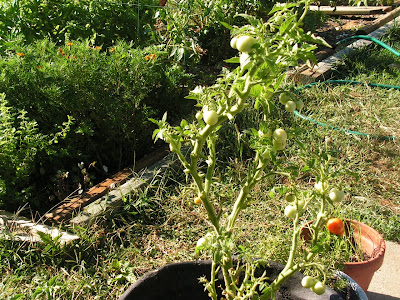 What's wrong with this pictures? Or rather, with the flowers on display?
What's wrong with this pictures? Or rather, with the flowers on display?A lack of pruning, that's what. This time of year, soil nutrients are often lagging, and heat saps strength in the plants, making transpiration (sweating leaves) fierce and more a hardship than a help to the plant. The plant must work much harder to get its leaves to create the sugars that keep the fruit sweet and the plant itself healthy when the soil is hard, the nutrients less rich and the waters less available.

One answer is to help the plant by minimizing its requirements. Something like a plant's version of liposuction, although not exactly. A flowering plant with dead blossoms dangling from its stems is sucking nutrients up those stems unnecessarily, which means another stem is sacrificing--maybe a stem that leads to a beautiful healthy blossom. Most flowers will benefit from "dead-heading" those blooms that are finished with their season. And when the spray of blooms is as prolific as these, the loss of a few dead blossoms hardly gives the plant a barren look. What's more, it enhances the uniform beauty of the blooms that remain.
But flowers aren't the only plants that can benefit from pruning. Recently, I had a friend give me a few pointers on pruning tomatoes. I promptly came home and took my pruning shears to my own tomato plants and zucchini.

A zucchini plant benefits in several ways from having a few of its leaves pruned. For one thing, air can circulate better through the part of the plant that is flowering and fruiting, making mold and mildew less of a problem.
For another, soil borne diseases are less likely to affect a plant that does not have its leaves literally lying across the ground. Some pests are less likely to find a home on leaves that are off the ground.

But the greatest benefit I'm seeing is in the tomato pruning my friend taught me. As I stood beside her in her own garden while she pruned her plants, I sighed and commented. "I'm so bad at this. I hate to cut away anything that isn't dead." Indeed, she was cutting ruthlessly at vibrant green leafing branches on her plant.
She smiled at me. "Well, it's true. In a way it is a life-lesson." She pointed one gloved hand at the branch she held and was about to snip. "See this branch?" she asked. "It's a non-producer. Notice how no blossoms are trying to form where it joins the main stalk? That's how you know it's a non-producer." Indeed, if a branch has no hope of producing a tomato, then its only benefit to the plant is that of photosynthesis. And many tomato plants, by late summer, spend more energy storing energy than they do ripening fruit. "You know it's time to do this when the plant stops making tomatoes, and when the tomatoes it already holds fail to ripen. If you prune back all but a necessary few leaves, mostly on top, you'll find the hanging fruit ripens nicely, and you might even start to see some new blooms."
She was absolutely right. Cutting away non-producers when producers begin to suffer the effects of age and weather, and weeding faithfully so the soil's nutrients aren't stolen by the things you never planted in the first place--these are your best hopes for maintaining productivity during the dog days of summer.
No comments:
Post a Comment